Trello vs Asana for Creative Agencies: Which Tool Wins in 2025?
Compare Trello and Asana for creative agencies. Learn which tool suits your projects, integrates with design software, and boosts team efficiency.

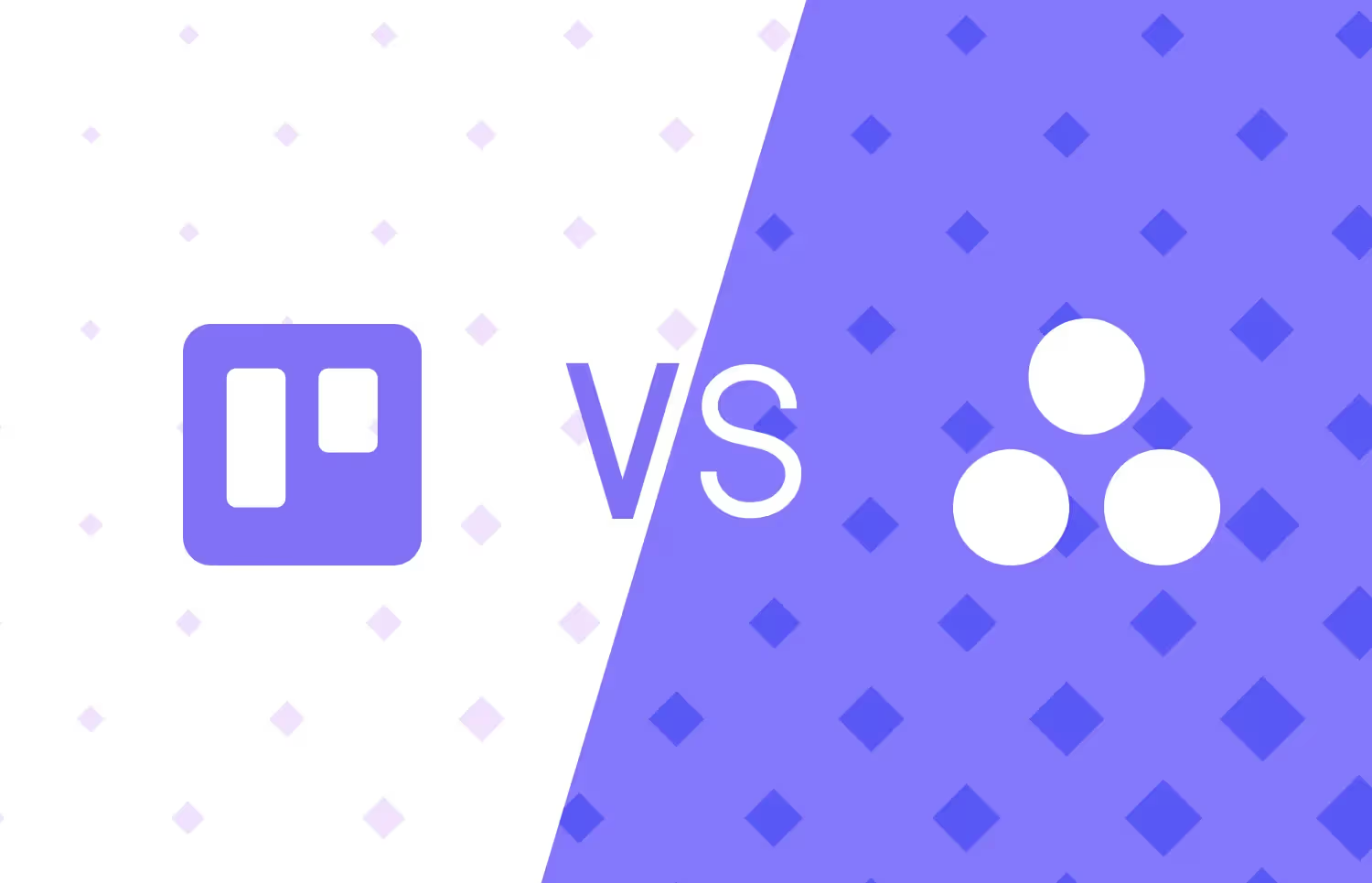


Trello and Asana handle creative projects differently.
Trello uses visual boards where you drag tasks like you would with sticky notes. Asana works as a complete project system to plan and track complex work.
If you are a creative agency owner confused about the best creative agency tool to go for, I will explain the differences between Trello and Asana. I'll also introduce ManyRequests as one of the best project management tools for creative agencies.
.avif)
But before we dive into the detailed comparison, here's a quick comparison matrix to evaluate each tool based on key criteria important to creative agencies:
Choose Asana if you:
Choose ManyRequests if you:
Before I explain what each project management tool does, here are some of their main differences:
Trello builds its tool around Kanban boards, with additional views requiring updates. Asana takes a more structured approach with multiple project views. You can switch between a list view, a board view, a timeline view, and a calendar view.
Trello is simple to use. You can add custom fields and manage basic tasks easily with Trello's Kanban board style. Asana is complex, but it has more advanced features.
Trello uses card comments and @mentions to communicate within the platform. Asana provides more communication options, including project conversations and direct messages.
Trello is a Kanban-based visual work management software for smaller teams and temporary projects. It's used to manage projects, workflows, and tasks, and is quite easy to use.

At its core, Trello functions through three main components:
Trello also offers other views like the Calendar view, Dashboard, and Timeline view, but they are mostly available in the Premium plans.

Let's look at some of its features:
Trello's Kanban boards let you manage tasks visually. You can drag cards between columns to show different work stages like "To Do" and "Done."

Each card holds task details: custom fields, attachments, due dates, labels, and descriptions.

Trello's Premium Plan provides extra views (like the timeline, table, calendar, and map in the image above), but they don't help creative agencies much. The timeline view, for instance, shows tasks in a calendar, but cannot track dependencies.
This means that you can't track which task is contingent on another. Trello's Kanban boards are its greatest feature for creative agencies.
Trello focuses on task-level communication. Your team members can:
There's no real-time collaboration feature, but you can integrate with platforms like Slack to communicate with your team.
Trello allows integration with many tools on any plan you choose.These tools can improve your experience on the platform. For example, you can connect Trello to Gmail to create cards from emails, and add automation to move cards between lists when you complete tasks. Trello calls these integrations Power-Ups.
Each Power-Up has a specific purpose. When you add Google Calendar Power-Up, you can set due dates that sync with your calendar. The Slack Power-Up lets you create Trello cards directly from Slack messages.Trello has
There's also an automation feature, called Butler, that can help your team:
Trello's reporting capabilities are basic. The platform offers:
For detailed analytics, you'll need to export the data as CSV or JSON files and analyze it in external software. Trello also lacks native time-tracking tools, which means that you can't track how your team manages their time within the app— you need third-party integrations to access this feature.

Cagri M, a content marketing manager, says that Trello is their “Go-To Tool for content Management and Team Collaboration”. He also mentions that “Trello can feel limited when managing more complex projects.”
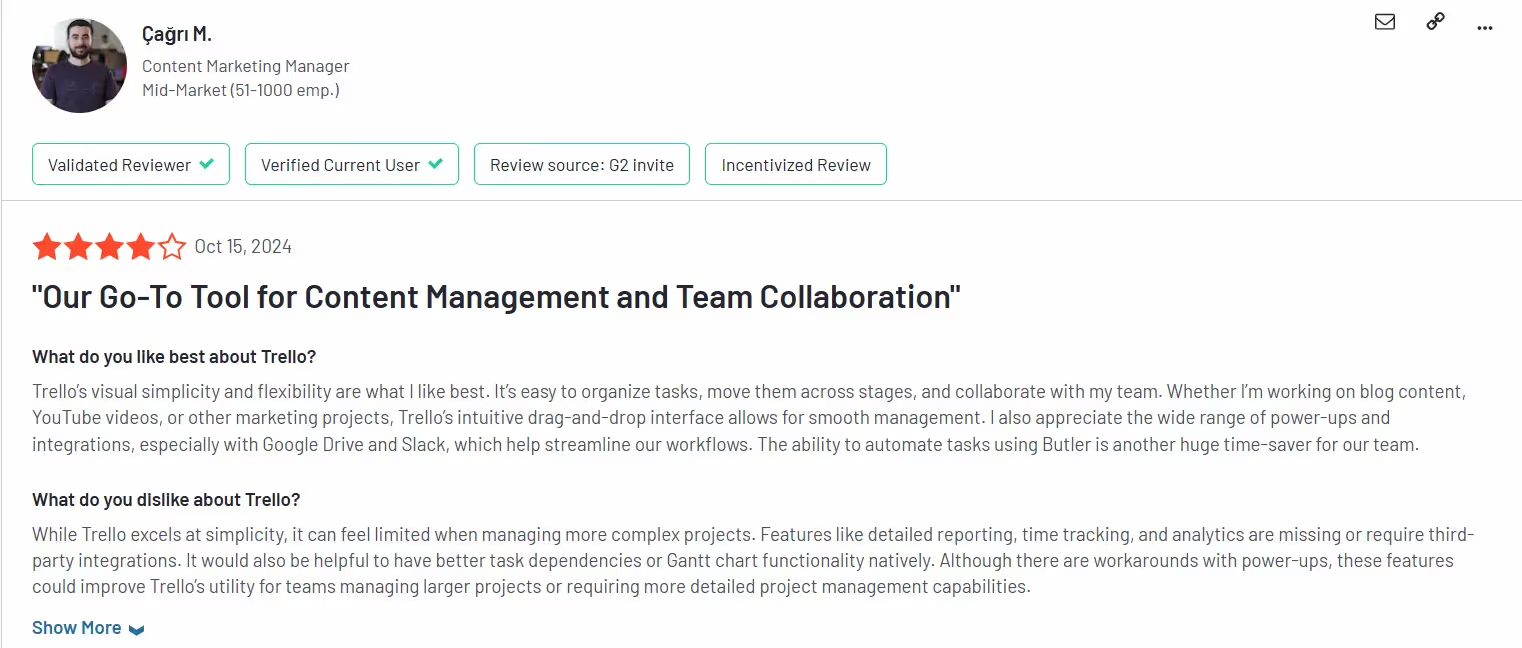
This neutral Redditor says, “It is less complex and expensive than most tools”.

Check Trello's G2 page to find more reviews.
Asana is project management software that helps teams organize, track, and manage work. You can create tasks, assign them, set deadlines, and monitor progress. Unlike Trello's singular focus on Kanban boards, Asana provides multiple ways to organize and track creative projects.

You can organize your project with Asana in five view formats:

Now, let's look at some of Asana's features:
Asana's portfolio view lets you manage multiple projects in one platform. You can also see a complete view of the team's work. In the Workload tab, you can see who has been assigned to which tasks.

Asana also uses effort tracking to measure work. You can set workload capacity, and when someone's workload exceeds their capacity, Asana shows a red line to alert you so you can take action.

Asana's drag-and-drop feature also lets you move tasks between team members or reschedule them for when the team member is now available.
The bummer is that the Workload feature only comes with Asana's Advanced and Enterprise plans, and you can't access it if you're subscribed to lower plans.
Asana's time tracking helps you monitor time spent on tasks.

You can enable time tracking in any project or My Tasks through the customize menu. This adds two fields: estimated time and actual time.You can track your team's time with the built-in timer that runs until you pause it, or enter tracked time manually.
Asana has more communication features for creative workflows. You can assign tasks to team members, and track the task from start to completion. You can also leave comments directly on tasks with @mentions. You @mention teammates to get their attention and they receive instant notifications. Here’s an example from Asana forum:

If the @mentions get too much, Asana lets you mute busy task discussions with the bell icon until you're ready to accept them again.
Task dependencies are task chains. Each task connects to another that must happen before or after it. When you set a dependency in Asana, you tell the system that Task A must finish before Task B can start.

Asana handles the communication automatically. When your team member finishes their task, the next person gets notified that they can start their work. No meetings or check-ins needed. For example, Asana tells the developer they can start coding after a designer finishes website mock-ups— and is approved. When coding is done, it signals to the marketing team to add the feature as part of their campaign.
Asana offers the following pricing plans:
Meredith S., a senior manager, says “Asana's made team communication easier for her team this year”, but admits that “the system is intimidating with all of its functionality.”

Another reviewer, Neha G, says “Asana is good for delegating tasks and tracking task completion.”
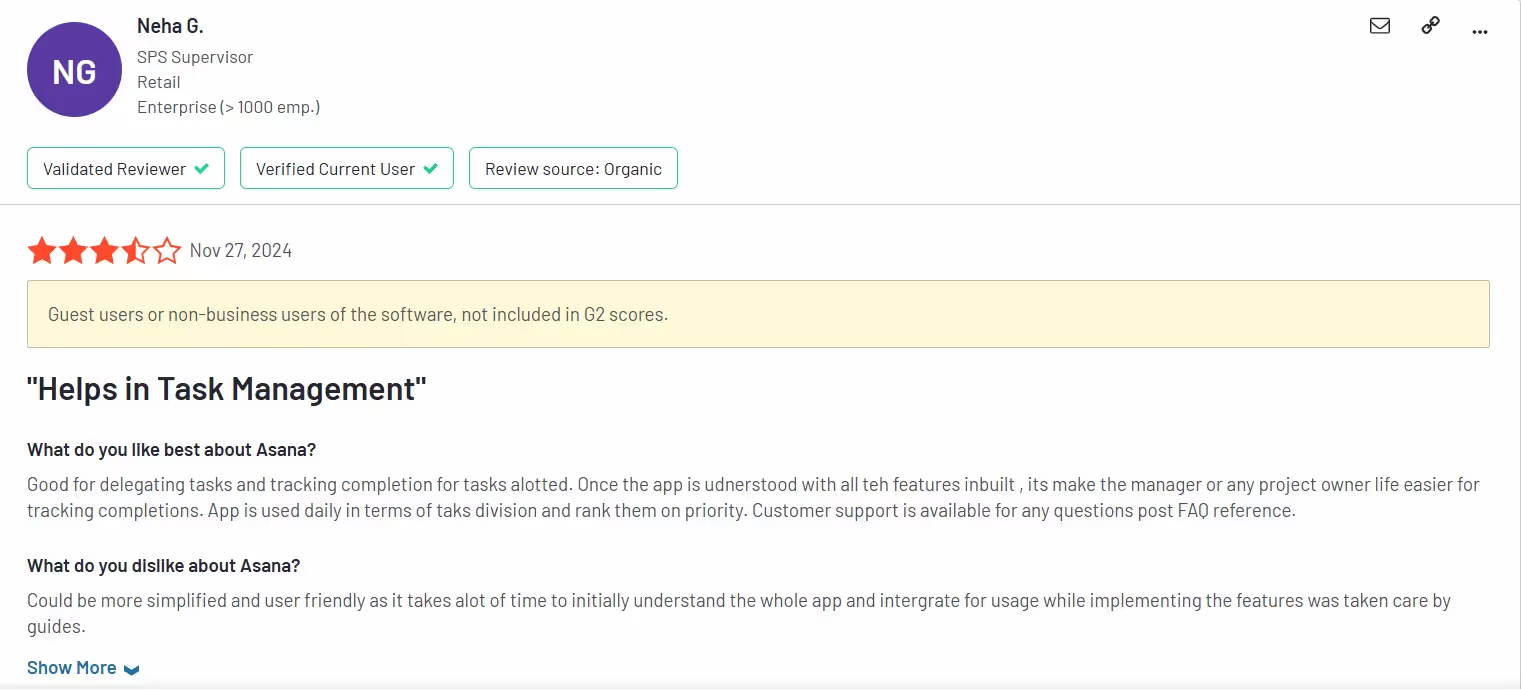
Asana and Trello are project management tools with valuable features to help your team manage projects better.
However, their efficiency depends heavily on your team, the kind of projects you handle, and whether you need a simple workflow management or a complex one.
Consider Trello if you have a small team of 5-10 members, and you only manage straightforward projects. If you have a large team that needs advanced task management, you should opt for Asana instead. Even Trello suggests using Jira if you have a large team:

However, if you want the best of both worlds (the Kanban view with advanced project and client management features), we recommend ManyRequests.
ManyRequests is a client-facing project management tool designed for creative agencies.
ManyRequests caters to creative agencies’ project and client management.
Let's explore some of its features:
Unlike Trello's Kanban-focused approach or Asana's broad project management features, ManyRequests manages client relationships alongside project workflows.

Here's how it does it:
ManyRequests provides a branded client portal where clients can submit requests directly into your workflow system. You can customize your platform to look and feel like an extension of your agency rather than ManyRequests'.
Some of the features you can customize with ManyRequests’ white-label client portal include:
Here's an example of a customized portal from Prontto:

Your clients can log into your branded portal, which looks and feels like your agency's portal, purchase your services through ManyRequest’s service catalog,
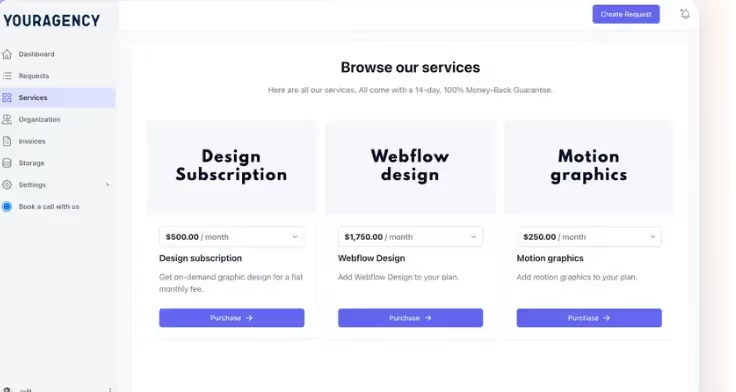
and submit their requests through a customized form.

You can customize your service request form to ask all the necessary questions you need to ask clients on the new requests.
While Trello or Asana requires that you create project structures manually, ManyRequests automates the process.When a client submits a request, the platform automatically turns it into a task in your system.
You can then immediately assign the task to team members.
Assignees will get an automated notification of tasks assigned to them, and they can change the status to signify that they've started or completed the task.

ManyRequests has more nuanced status options than the usual “To Do, In Progress, Complete.” Your tasks can move through stages like:

Depending on what stage the task is at, project managers can monitor their team members to know their workload, task status and when to assign pending requests to them.
ManyRequests tracks time in real-time. You can track how much time your team spends on client projects directly as they work on them.

You can also share these reports with clients when billing them— ManyRequests also lets you share time with clients as you track it. It shows transparency in how much time your team spends on their work, especially if you're charging per hour, or you want to know how to convert the value of time to money when billing.
You can track time with ManyRequests in two ways:

They don't have to be online to track time— the system syncs when there's an internet connection. After they stop the time tracker, ManyRequests brings a detailed pop-up form so team members can add descriptions of their work.
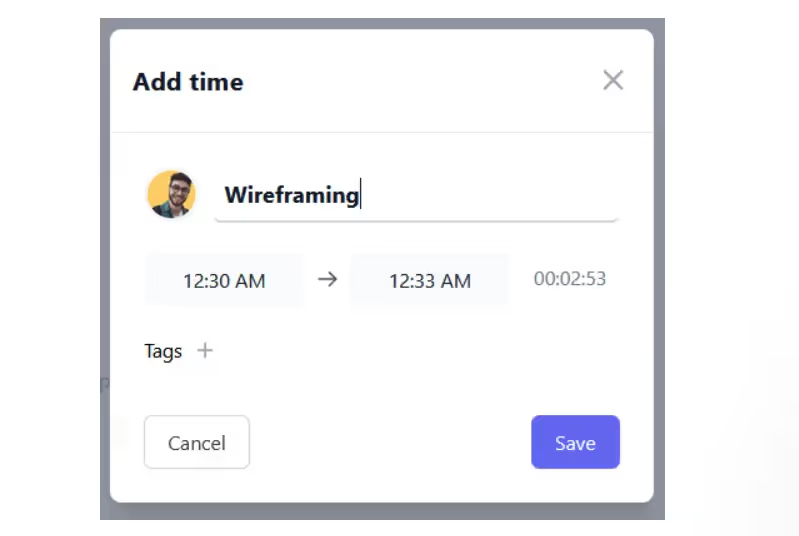

ManyRequests also integrates with Stripe to bill your clients, so you can generate invoices automatically based on tracked time. You can also set up hourly or fixed-rate billing, send invoices to clients, and receive payment without leaving the platform.
Every task on ManyRequests has a discussion space. Your team can handle meetings, share updates, and discuss with clients on the platform, if you want them to.

You can create tasks and assign them to team members. Each task has its thread where your team can;
ManyRequests also has a design annotation tool to help clients and team members leave feedback on design documents.
If your designer shares design documents with clients or colleagues, they can click directly on the design to leave feedback. Each click creates a numbered pin, with comments, on the exact spot that needs iterations. For example, in the image below, the client needs the design to pop more than it does.

The designer understands what needs to be done because the comments are on the exact spots. Every individual pin has its comment threads to keep feedback organized.
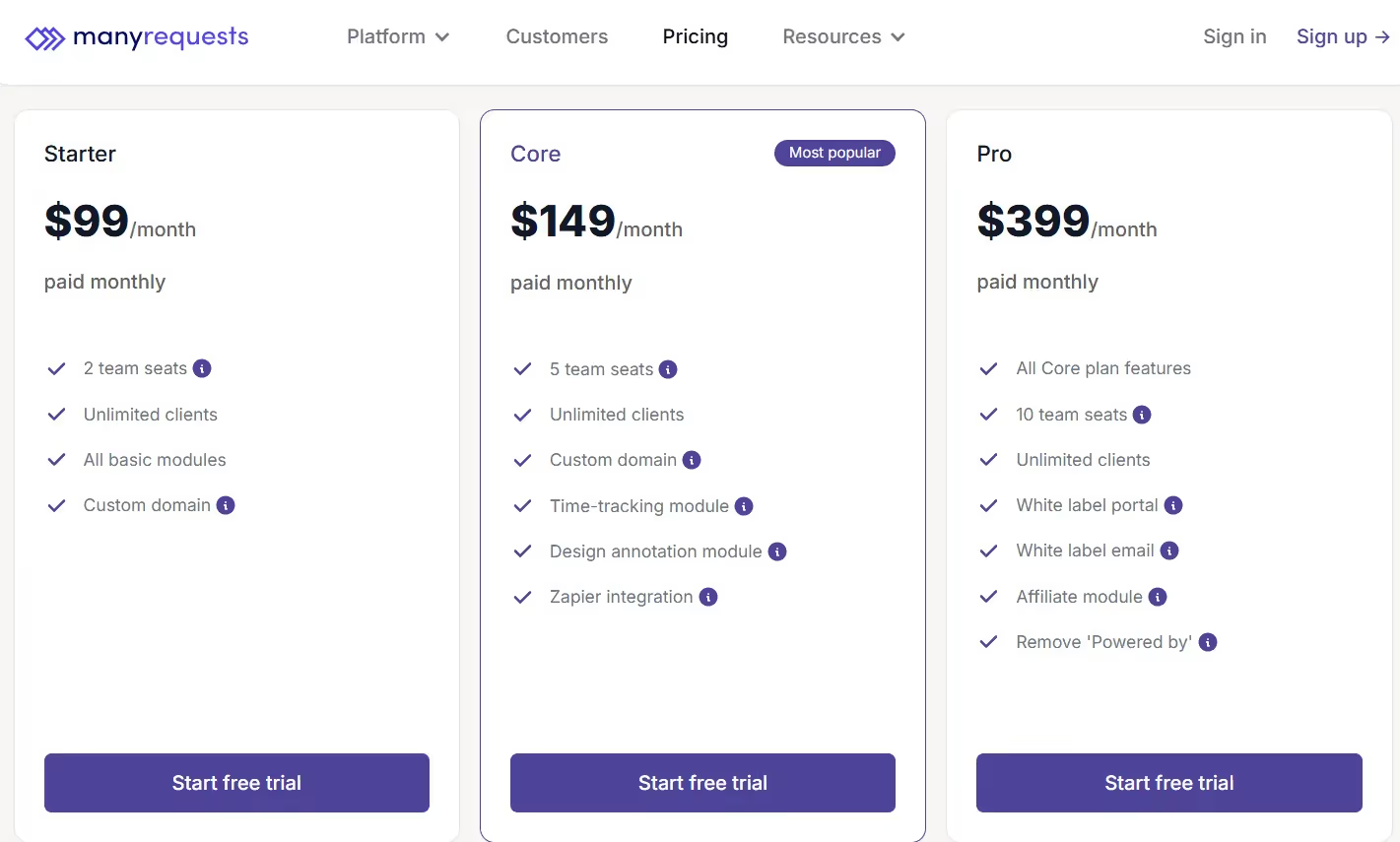
ConclusionYour choice of project management tool should depend on your agency's needs. From the above, it's clear that:
ManyRequests combines the best of all worlds with its project management and client portal. You get one platform to manage all active tasks, chat with clients, track time, and bill clients without administrative issues. Your clients can also make requests for specific deliverables via custom forms and provide feedback directly on task boxes. Sign up for a 7-days free trial (no credit card needed) to see how it works.